Is the dream of a hydrogen-fuelled future still a pipe dream, or is it in the pipeline? Angeli Mehta investigates
Somehow or other, we need to cut energy-related carbon dioxide emissions by 60% in the next 30 years, to limit global warming to 2°C. Tackling the challenge is all the more urgent as the global population grows and gets wealthier. Throw in the damage being done by the related air pollution, and it’s not surprising that the spotlight is back on an abundant element that produces no carbon emissions when burned, and has double the energy density of fossil fuels: hydrogen. The attraction of hydrogen is that it can be used both as a feedstock and an energy carrier.
Across the world, researchers are trying to improve the efficiency and costs of producing, storing, transporting and using hydrogen in applications as diverse as heat and transport. Developments are coming thick and fast: from advances in hydrogen production to new catalytic materials that could replace platinum in polymer electrolyte membrane fuel cells that will cut their cost. Demonstrator projects are underway that may provide the numbers and the technology to show where and how hydrogen can replace fossil fuels. But at some point politicians will have to make a decision to encourage the infrastructure to be built. What’s required is nothing short of re-imagining our entire energy system, says Jon Clipsham, hydrogen development manager at the European Marine Energy Centre in Orkney, UK.
Japan has already made that commitment, following the tsunami and resulting nuclear disaster at Fukushima in 2011. It intends to use the 2020 Tokyo Olympics to showcase the technology with thousands of hydrogen fuel cell vehicles, a network of filling stations and a hydrogen-powered athletes’ village. Japan’s car makers are selling hydrogen fuel cell vehicles and Toyota is building a plant to manufacture fuel cell stacks. Japanese homes are being equipped with fuel cell technology to provide electricity and plants are being built to make hydrogen using renewable energy. The country will also import hydrogen, with Australia the seeming front-runner, using its plentiful coal supplies to make hydrogen and capturing the resulting carbon dioxide emissions.
Making the lightest element
The bulk of hydrogen is made today by steam reforming methane, but this has to be combined with carbon capture and storage – or better – utilisation, if it’s to be emissions free. However, the carbon dioxide emissions are still estimated to be 25–35% lower than with diesel. ‘It’s not the final picture, but a good intermediary,’ Pierre-Etienne Franc, vice-president of advanced business and technology at Air Liquide, told Chemistry World after the launch last year of a worldwide collaboration, the Hydrogen Council.
Hydrogen is also produced by electrolysing water, providing the pure hydrogen needed for fuel cells, but it’s less efficient and more costly than steam reforming. The Sustainable Gas Institute has estimated the cost of hydrogen production through electrolysis at 4–9p per kWh, compared to 2–5p per kWh for steam methane reformed natural gas with carbon capture and storage.
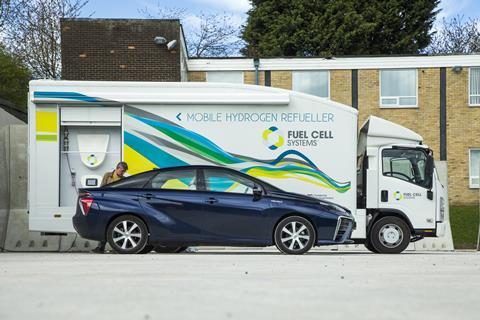
Scale-up will reduce that gap, and provide a means to harness excess renewable energy that would otherwise be wasted. Storing the hydrogen produced could buffer intermittent daily and seasonal electricity generation. Last year, for example, UK wind farm owners were paid a reported £100m to turn off turbines when there was more energy than the grid could cope with. The Hydrogen Council envisages that by 2030, 230–250TWh of surplus solar and wind energy could be converted to hydrogen. It suggests hydrogen could provide almost a fifth of total energy consumed by 2050, and cut carbon emissions by about six billion tonnes compared to today. Moreover, it will tackle the air pollution that is the scourge of so many industrialised nations.
Other technologies are being explored. The Hazer Group, spun out of the University of Western Australia, has developed an iron ore catalyst to convert natural gas into hydrogen. A major advantage of the process is that the carbon is captured as synthetic graphite to be used in lithium-ion batteries. Last year, the company produced the first hydrogen and graphite from a pre-pilot plant, and is working to optimise conditions to run the process continuously.
Using the sun’s energy to split water is another major research topic, and the hunt has been on for suitable electrode materials since it was first demonstrated by Japanese scientists over 40 years ago. Scientists at Exeter University in the UK think they might have developed it: a photo-electrode, made from nanoparticles of lanthanum, iron and oxygen, that liberates hydrogen from water.1 Elsewhere, an EU funded project has developed reactor for solar thermo-chemical hydrogen production at the Hydrosol plant in southern Spain. It can now produce 750kW of power (enough to power around 200 households), and has produced hydrogen in kilogram quantities. The researchers anticipate the technology will be feasible at scale in around ten years.
Systems rethink
Can renewables produce enough green hydrogen to meet our needs, and might hydrogen boost commitment to renewables? Clipsham believes so: ‘The Orkneys are awash with hydrogen.’ Its existing cluster of tidal, wind and wave power has a capacity of over 5MW of power – but the potential for some 5GW. That’s more than the output of the Drax power station in Yorkshire. But Orkney can’t add any more capacity to the UK grid without expensive new subsea cables.

Emec is one of 12 partners from across Europe collaborating in Orkney’s Big Hit project. This is designed to demonstrate that otherwise-curtailed renewable energy can be used to produce hydrogen that can be stored and used in a range of heat and power applications: providing fuel for a fleet of hydrogen range-extended light vehicles, heating buildings and providing auxiliary power and heat to ferries docked in Kirkwall harbour.
Researchers at the Technical University of Denmark in Roskilde will analyse the costs and environmental impact. Eva Ravn Nielsen explains that they’ll calculate the exact cost per kWh of electricity produced for each service, as well as the environmental impact from cradle to grave to accurately compare Orkney’s integrated system with what’s available today.
‘We have a huge natural resource with wave and tidal power, and 15 years of experience with metal in the water,’ says Clipsham. ‘For that to progress [it] needs a route to market.’ And for that investors have to be persuaded. Hence, an €11m (£9.6m) project to integrate reliable tidal energy into the European grid, using hydrogen to store and deliver excess capacity.
The World Energy Council envisages hydrogen conversion could take place on retired oil and gas platforms in the North Sea, and the existing pipeline infrastructure used to bring the gas ashore. Its analysis for using windpower suggests offshore and onshore electrolysis could provide a capacity of 10GW by 2030, and over 50GW by 2050, for an investment of anywhere between €27 and €37 billion – most of which would go on electrolysers.
Chickens and eggs
Fuel cell developers say the biggest struggle is to get production volumes up enough to create the economies of scale that will bring costs down. But that requires demand, which requires infrastructure.
In May, the UK government launched a £20m fund aimed at driving down the costs of making hydrogen, or at least to improve the potential for emissions savings. Separately, a team led by design and engineering group Arup will define a hydrogen quality standard, and develop and test domestic and commercial hydrogen appliances as part of a £25m programme. For appliance manufacturers there are practical challenges, as hydrogen is colourless and odourless, and emits ultraviolet light when burned.

ITM power, based in Sheffield in the UK, is upgrading five existing hydrogen refueling stations, and will add another four with £4.3m from the Department of Transport. The government also wants to see hydrogen trains running on the network, as part of a commitment to remove diesel rolling stock by 2040. As a first step, French train maker Alstom – which is trialling hydrogen trains in Germany – is to add hydrogen fuel tanks and fuel cells to some existing electric trains. Hydrogen fuel cell buses are being deployed across Europe, and Scotland is an early adopter. The project hopes to drive commercialisation so the buses are economically viable without subsidy, thus encouraging governments to regulate for zero emissions public transport.
Using hydrogen
Industry already uses about 55 million tonnes of hydrogen a year as a feedstock, and hydrogen is itself produced as a by-product of industrial processes. UK chemical company Ineos uses hydrogen that is a byproduct of its chlor-alkali production to provide some of the fuel for its gas boilers, and supplies hydrogen to fuel cell manufacturers. When chemicals group Sabic re-engineered its ethylene plant on Teeside to use cheap ethane feedstock from the US, it also changed the burners on its furnace to use the hydrogen that is a by-product of ethane cracking.
Hydrogen would enable captured carbon dioxide from industrial processes to be recycled into chemicals, for example methanol. The George Olah plant in Iceland recycles over 5000 tonnes of carbon dioxide annually. Named after the 1994 Nobel chemistry laureate it uses electrolysis to produce hydrogen, which is converted in a catalytic reaction with carbon dioxide to produce five million litres of methanol. The carbon dioxde is captured from the flue gas of the neighbouring geothermal power plant.
A major European project Carbon2Chem is rethinking the problem of fluctuating renewables by using large industrial facilities like steelmaking as energy buffers. The idea is that chemicals would be made when there is cheap surplus renewable energy for hydrogen production. The challenge is to design catalysts and processes that can cope with fluctuations, rather than the continuous production of today. The project, at ThyssenKrupp’s steel plant in Germany, is expected to reach scale in about 10 years. Emec’s Clipsham suggests hydrogen might also enable chemical synthesis to be distributed across smaller sites than at present.
Clean then green
Removing hydrocarbons from the UK’s heating network – which accounts for over 30% of emissions – is proving a hard nut to crack. However, existing infrastructure could be repurposed to use hydrogen – helpfully, the existing iron pipe network is currently being replaced with polyethylene, which could carry hydrogen. And there is a precedent: before natural gas was discovered, heat was produced by burning town gas, comprising around 50% hydrogen.
As a start, Keele University in the UK hopes to blend to 20% hydrogen with natural gas and inject the mixture into its campus network by spring next year. The Health & Safety Executive is now reviewing Keele’s proposals. Ian Madley, head of partnership development at Keele, says researchers have spent the past 15 months working to establish that there are no additional risks of adding hydrogen. ‘There’s been a lot of chemistry done, to make sure none of the materials are adversely affected by hydrogen [….] and how the hydrogen behaves if there are leaks,’ he explains. ‘What we’re trying to do is answer the question: can you inject hydrogen into the gas network at a high enough level to make a difference and follow the hugely variable daily and seasonal changes in demand for gas?’ The hydrogen will be produced by electrolysis. A later stage of the research envisages adding wind energy into the mix, to see if demand can be met from a fluctuating renewable.
The thinking is that a wider roll out of a hydrogen mixture would help bring carbon emissions down relatively quickly while other technologies are being developed. Across the UK, the team say it would cut carbon dioxide emissions by 6 million tonnes a year – the equivalent of taking 2.7 million cars off the road.
There’s been a lot of chemistry done, to make sure none of the materials are adversely affected by hydrogen
Can we go further than 20%? The H21 project scoped out repurposing the entire gas network of the UK city of Leeds to use hydrogen. It proposes that hydrogen be produced by four steam methane reformers located on Teeside, and the resulting carbon dioxide compressed and stored in depleted gas fields. Hydrogen to meet daily and inter-seasonal demand could be stored in existing salt caverns. Equivalent studies are underway in Australia and Ireland.
Dan Sadler, H21 project manager, told a recent conference that he equates the task of meeting climate change targets to ‘rebuilding your house by next Friday’. The logic of H21 is ‘to get to clean, in the timescale available, then get to green over the longer term’.
Storage solution
The question of how to store hydrogen and move it around efficiently is a pressing one. Hydrogen’s low density means it has to be stored at pressure, and therefore cooled.
Hydrogen fuel cell vehicles use reinforced carbon fibre tanks with a plastic liner, which deliver hydrogen at the purity required by fuel cells. ‘So far no one has come up with a better solution,’ according to David Book, a professor of energy materials at the University of Birmingham in the UK. ‘Metal hydrides, magnesium alloys with nanoscale microstructures – there’s always some kind of fatal flaw.’ That could be to do with temperature or getting hydrogen in or out. Where weight is less of a consideration, such as in stationary applications or powering ships, hydrogen could be stored at lower pressures in larger tanks.
There might be more efficient ways to move hydrogen around, and store it, in bulk. One option is to convert it to ammonia – an industrial product that is shipped in large quantities all over the world. It has the highest hydrogen density of fuels used today. Where renewables aren’t available to make hydrogen directly, ammonia could provide a viable solution.
Not many things that are carbon-free give you that amount of energy, for a relatively compact footprint
Siemens and its university partners have just launched an ammonia storage demonstrator in Oxfordshire, UK, that will run the entire cycle of producing hydrogen from renewable energy; making ammonia and cracking it back into hydrogen and nitrogen. Now they intend to find out if the Haber–Bosch method can cope with the intermittency of wind energy. Current industrial synthesis of ammonia accounts for 2% of global carbon dioxide emissions, so to produce it from renewable energy via hydrogen would make a big impact.
According to Ian Wilkinson, programme manager at Siemens, 90% of the energy used to make ammonia is in the hydrogen production. Cracking it back again will also require energy but that’s a relatively small part of the equation, he says, especially using catalysis to bring the temperature down. A 20,000 tonne tank would produce some 50GWh of electricity assuming a gas turbine with 50% efficiency – as a comparison, Tesla’s Gigafactory in the US state of Nevada will have a production capacity of around 35GWh. ‘Not many things that are carbon-free give you that amount of energy, for a relatively compact footprint,’ says Wilkinson.
While ammonia could be burned in a power station – without carbon dioxde emissions – both it and hydrogen produce nitrogen oxides (NOx) emissions when burnt (ammonia obviously more so). Reducing emissions is an active research area, and ironically ammonia itself can clean up NOx emissions under the right conditions.
Another promising technology involves reversible hydrogenation of aromatic compounds. Chiyoda, an energy company based in Tokyo, Japan, is using toluene: hydrogenation produces methylcyclohexane (MCH), which can be stored as a liquid at ambient temperature and pressure. When required, the hydrogen can be liberated through a process of dehydrogenation, and the toluene recycled. Chiyoda anticipates that Japan’s existing petroleum distribution infrastructure could be repurposed to handle MCH. Hydrogenious, a German company spun out of the University of Erlangen–Nuremburg , works with dibenzyl toluene. It says 57kg of hydrogen can be stored in one cubic metre of the liquid carrier – that’s enough to fill about 12 cars.
Might hydrogen prove to be an indispensable tool in enabling renewable energy to power our planet? There’s no shortage of potential applications. But there is some urgency.
Angeli Mehta is a science writer based in Edinburgh, UK
References
1 G S Powar and A A Tahir, Sci. Rep., 2018, 8, 3501 (DOI: 10.1038/s41598-018-21821-z)
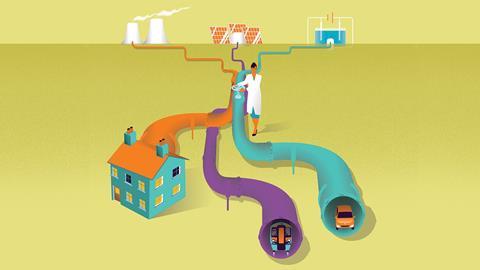
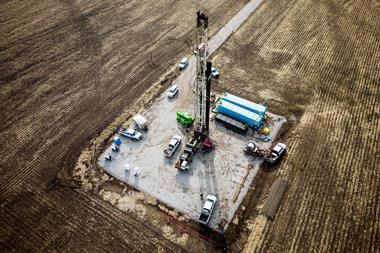
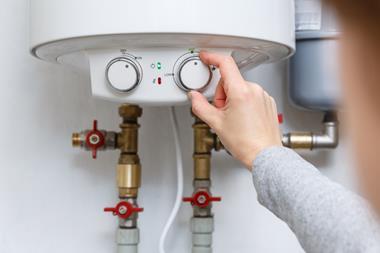


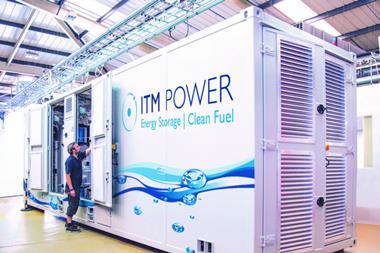







2 readers' comments